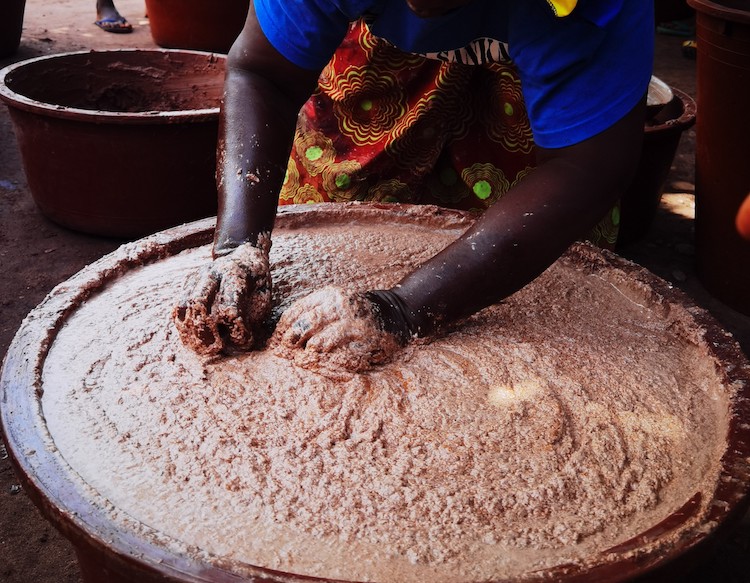Fair trade shea butter: a development engine for women producers

The shea tree ( Vitellaria paradoxa syn Butyrospermum parkii , its former name) is an endogenous tree from the tropical regions of Africa which belongs to the Sapotaceae family. This unique tree species is native to West Africa, particularly the savannah of Burkina Faso. Even today, the main producers are in the West of the continent: Nigeria, Mali, Burkina, Ghana, Ivory Coast.
The shea tree is a slow-growing tree that can reach around fifteen meters in height. Its branched branches bear oblong leaves, measuring up to 20cm long, gathered in bouquets at the end. At the heart of each bouquet of leaves bloom creamy white flowers in umbels, which are fragrant and honey-producing.

Shea butters, ovoid fruits, are berries gathered in clusters. They are fleshy and each contain an almond very rich in fat, used to produce shea butter. If you are lucky enough to taste the pulp surrounding the almond, it is delicious and rich in vitamin C.

The reappropriation of shea by African women
Shea and its uses were first described in the 14th century by a Moroccan traveler, followed 500 years later by a Scottish explorer who gave shea its first scientific name.
'The collection and manufacture of shea butter are operations mobilizing ancient knowledge held by rural Burkinabè women. The transmission of knowledge for these operations and gestures is part of intergenerational dynamics of learning body techniques. Women's knowledge includes how to use their body, the beauty of the technical gesture as well as its effectiveness. » - Extract of Gender, agrarian changes and food – Christine Verschuur

Then, during the colonial era and again for decades, shea nuts were mainly sent raw to Europe (Netherlands, Denmark) to be processed and refined. Production is then intended for the food market and more recently for the cosmetics industry. Western companies and businessmen then have control over this treasure.
In 1984, Burkina Faso adopted an egalitarian law guaranteeing women better access to land and natural resources. However, in a context of growing demand for shea, men have developed commercial strategies to the disadvantage of women: by seeking to sell as many almonds as possible to collectors/exporters, they constrain (in terms of price) and limit (in quantity) women's access to this raw material which is nevertheless essential to them.
Over the past forty years, fair trade and direct trade have developed, once again allowing women to benefit from this resource and their know-how. These fair trade circuits connect women's associations in rural African communities to consumers all over the world.
Today, Western production of refined shea remains in the majority, but African production of natural shea is an almost exclusively artisanal and feminine affair. Across West Africa, 16 million women produce 800,000 tonnes of butter.

Umano fair trade shea butter comes from a rural community in Burkina Faso, in Orodara. This is also where our partner for mangoes and cashew nuts, Coopake, is located.
In Orodara, the association of shea producers has around twenty members. By getting closer to our partner Coopake, they were able to improve their income, their production capacity and above all access a market and better remuneration for their work.
Why natural and unrefined shea butter?
In terms of appearance, natural (unrefined) shea butter is characterized by:
- Its color: yellow
- Its odor: light but characteristic, which evaporates approximately 5 minutes after application.
- Its texture: it is solid but creamy and absorbs well into the skin and instantly softens it.
It is found in solid form at ordinary temperature (< 35°C).

It is the restorative, nourishing and protective virtues of shea butter that have made this solid fatty substance famous in herbal medicine. Shea contains antioxidants, saturated, monounsaturated and polyunsaturated fatty acids, terpene alcohols, vitamins A, D, E, F, and unsaponifiables.
Thanks to the care taken by the producers, our shea butter is very pure (impurity index less than 0.01%). Analyzes reveal an excellent peroxide index, very low, and an acidity level in compliance with standards.
At Umano, our fair trade and organic shea butter is an unrefined butter, extracted directly at the cooperative using the traditional method.
Source:
